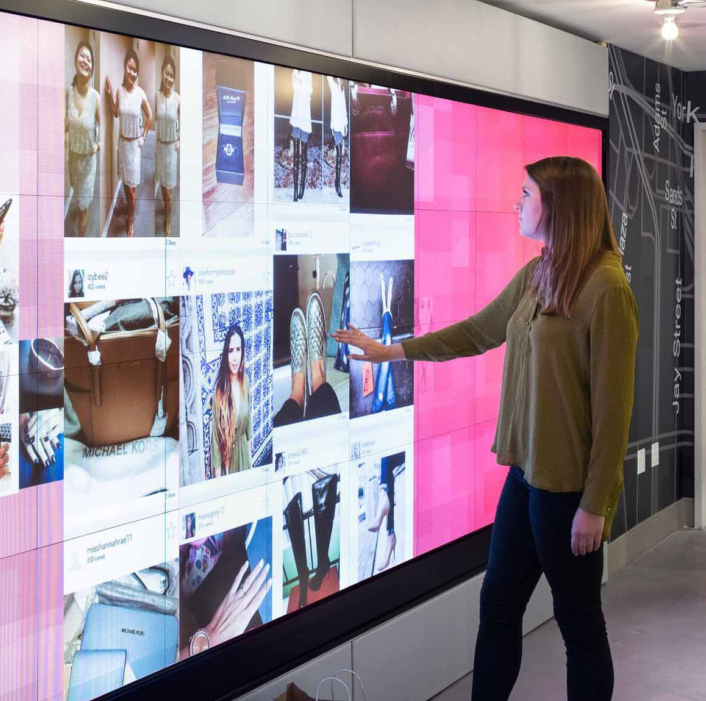Research firm Markets and Markets has predicted that by 2023, the Digital Out-of-Home (DOOH) market will reach $26.21 billion. According to the firm, North America is leading DOOH with its early adoption of the latest display technology, with retail and hospitality being the strongest commercial players in this realm. But the opportunities don’t stop there, and AV design and integration companies stand to benefit as corporate campuses, banks, government agencies, and public and commercial transport bodies all explore how digital signage—specifically, interactive displays—can assist in the distribution of advertising, entertainment, and information.
For organizations whose job is to create stickiness with consumers, interactive digital signage offers more potential to achieve customer engagement. “What interactive digital signage has over static signage—or signage that’s not interactive—is the ability for the viewer to click through ads and interact and engage with advertising messages,” said Christina Radigan, managing director of marketing and communications at Outdoor Media Group, an Out-of-Home (OOH) media buying agency network headquartered in Jersey City, N.J. The digital ads that are being created today are already programmed for interaction, “so that is where I see the compelling proposition of interactive digital signage.”
TJ DiQuollo, director of creative services at Diversified, notes that the integration of augmented reality (AR) and artificial intelligence (AI) with digital signage technology will provide more opportunities for engagement. “I’m looking forward to how augmented reality is going to offset some of the physical interactions with signage, and also how artificial intelligence is going to help create interactive experiences that are very specific and very tailored to the user,” he said. While users may already interact with signage via their smartphones—he cites AR-based way-finding apps as an example—he believes that wearables are the next frontier. “Future augmented reality is going to take the phone out of the equation. In that case, there will be a whole new world of potential—especially for retail and advertising, where you will be able to interact with new products that aren’t even there, and imagine them as if they were sitting there on the table, right in front of you.”
The very nature of the smart city model is another area that lends itself to interactive digital signage. A number of cities across North America are currently enhancing their infrastructures to boost connectivity between government agencies, public service providers, and citizens, and interactive digital signage is often one of the best ways to achieve this. “Interactive, combined with geospatial mapping, allows a user to [access] way-finding,” Radigan said. The same displays could also be programmed to enable users to access breaking news, alerts, and traffic data—the kind of information that is useful to those trying to get around town and go about their day. “It’s already starting to grow, but I think within the next decade, smart cities are going to be a huge opportunity for interactive digital signage.”
Along these lines, Carousel Industries is in the process of rolling out a project that will equip the state of Florida’s Department of Motor Vehicles (DMV) locations with interactive displays, as well as videoconferencing technologies. The systems are designed to serve as remote tellers that drivers may interact with in an effort to facilitate the license renewal process, explained Brian Fichter, director of portfolio strategy, video collaboration, at Carousel. “I think remote tellers will continue to grow—I think it keeps the costs in check for the different [agencies], and it centralizes and streamlines processes,” he said. And, it may make having to deal with the DMV a little less unpleasant.
On a more modest level, Fichter points to the development of “all-in-one” displays that incorporate interactive capabilities, audio, cameras, and features such as white boarding functionality as good solutions for smaller deployments. “There is still this craze for small to medium-sized huddle rooms, and these all-in-one displays fit that model nicely,” he said.
Fichter argues, however, that the actual technology is only part of the equation; content is what drives the message that brands, sports and entertainment franchises, government agencies, and municipalities are trying to get across. “The digital signage piece is pretty basic when it comes to the hardware and software—it’s a player, a receiver, and a display, and the network in between. But the content creation piece, I think, has been the struggle for a lot of service providers,” he said. Determining who will create the content, who will develop the templates, and who will manage updates is a challenge for organizations that don’t necessarily have these resources in-house; in these cases, outsourcing these tasks to a capable provider is the solution. “The content piece is the sticky piece. That’s where I think service providers add the most value. It’s not a set-it-and-forget-it technology, that’s for sure.”
And, for AV firms that are addressing this need by offering content-related services, the lines are blurring between content creation and management, design, and technology deployment and monitoring. But at the same time, it’s all about the content. “The real potential is around the creative application of it: how do you evoke the emotion of the person interacting with the device?” DiQuollo said. For brands, the goal is building a bond with consumers, which is the work of creatives, marketers, and agencies—entities with whom DiQuollo and his team members are in regular contact. “It’s really the creative application for how you’re using that technology that is an open-ended question, and it could take you anywhere you need to go.”
